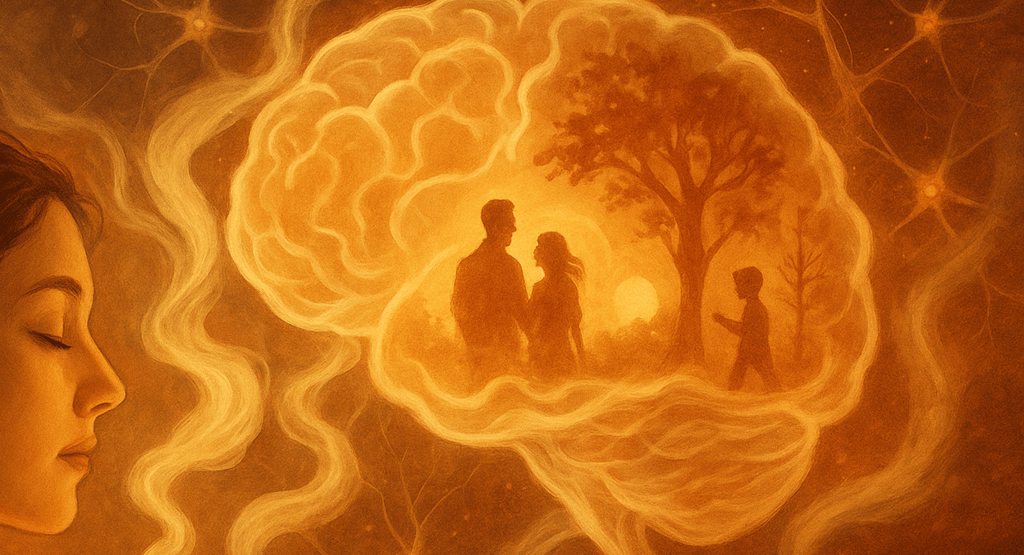The Psychology of Fragrance and Memory
We attempt to explain how scent is processed through the limbic system and why certain smells are powerful triggers for emotions and nostalgia.
THE SCENT DAILY
7/9/20254 min read


We've all experienced it: a sudden fragrance wafts through the air, and in an instant, we're transported to another time and place. Perhaps it's the aroma of freshly cut grass reminding you of carefree childhood summers, or the gentle scent of lavender bringing you back to your grandmother's house. But why does smell have this power? How is it able to evoke vivid memories and deep emotions?
The answer lies within our brain's architecture, which is complex enough, but scientists believe it is specifically connected within an area known as the limbic system.
How Smells Reach Our Brain
Our sense of smell, or olfaction, starts when airborne odor molecules dissolve in the thin layer of mucus high inside your nose and lock onto specialized receptor proteins. Each receptor fits only certain chemical shapes, much like how a lock opens only for a single key. The moment an odorant clicks into place, the receptor cell fires an electrical pulse that races along hair‑like axons passing through the cribriform plate (a porous bone behind your nose) and into the olfactory bulb, a small, elongated structure at the very front of the brain.
From here the story diverges from every other conscious sense. Vision, hearing, taste, and touch all make a mandatory stop in the thalamus—a dual‑lobed mass of grey matter that can be visualized as the brain’s gatekeeper. The thalamus acts as a sophisticated air‑traffic controller: it filters the flood of incoming data, dampens background noise, and decides which signals deserve your limited attention before routing them on to the appropriate cortical areas.
However, smell is different. Instead of having to go through the thalamus, it takes an express lane. Axons from the olfactory bulb project directly into the limbic system, a collection of evolutionarily ancient structures that includes the amygdala (where raw feelings like fear and delight are first stamped onto experiences), the hippocampus (which encodes events into long‑term memory), and portions of the hypothalamus (which keeps tabs on hunger, thirst, and hormonal balance). Because olfactory information bypasses the thalamic checkpoint, it reaches these emotional and mnemonic hubs milliseconds faster and with very little filtering.
Researchers theorize that evolution likely preserved this shortcut because, long before humans relied on sight‑dominant cognition, rapid smell detection could literally save a life: the scent of smoke signalling fire, the sharp reek of spoilage warning of dangerous food, or the musky trace of a predator drifting on the wind. The result in modern life is a neural superhighway that allows a single whiff of sunscreen, pine needles, or your partner’s perfume to ignite a cascade of vivid memories and emotions before you’ve had time to form a conscious thought.
The Limbic System as Our Emotional and Memory Headquarters
The limbic system is an ancient part of the brain, crucial for emotional processing, memory formation, and survival instincts. It includes key structures like the hippocampus (essential for memory creation) and the amygdala (crucial for emotional responses).
When we smell something, the olfactory bulb transmits signals to these areas. The hippocampus helps form and store memories, linking scents with specific experiences. Meanwhile, the amygdala assigns emotional significance to these memories, determining how strongly we feel when we encounter a particular fragrance.
Because this system is so closely tied to our emotional core, memories associated with smells tend to be more vivid and emotionally charged than those triggered by other sensory inputs.
The Proustian Phenomenon
Marcel Proust famously described in "Remembrance of Things Past (La Recherche)" how the taste and aroma of a madeleine pastry dipped in tea vividly resurrected memories of his childhood. Today, this powerful sensory memory trigger is known as the "Proustian Phenomenon."
Science supports this literary insight. Research has shown that memories evoked by smells are often more emotionally intense and vivid than those triggered by sights or sounds. This is due in large part to the immediate and robust activation of the limbic system by olfactory stimuli.
Most early‑childhood memories fade (a phenomenon called infantile amnesia) because they were encoded before we had words to rehearse them. Memories related to scent, however, are stored as multisensory–emotional patterns inside the amygdala and hippocampus; they do not rely on verbal labels to survive. When an adult nose meets a childhood odor, the original non‑linguistic imprint can surface unchanged, even if we cannot articulate why it feels familiar. This is why memories associated with scents tend to be older and from earlier life periods. For instance, the smell of sunscreen might evoke memories of family beach vacations, or pine needles might instantly recall festive holiday gatherings.
How Fragrance Shapes Feelings
The strong emotional reactions we experience from scent aren't coincidental. Scent-driven emotions are deeply rooted in evolutionary survival mechanisms. Historically, our ancestors depended heavily on smell for identifying danger, food, and potential mates.
Today, perfumers and marketers leverage this powerful connection between scent and emotion to evoke specific feelings or states of mind. Lavender is commonly used for its calming effect, citrus for energy and alertness, and vanilla for comfort and warmth.
Moreover, aromatherapy, the therapeutic use of essential oils and fragrances, utilizes scent as a tool to manage stress, anxiety, and depression. Clinical studies increasingly support the efficacy of aromatherapy.
Why Some Smells Trigger Stronger Memories
It is important to know that not all scents evoke powerful memories or emotions equally. The reality is that several factors can enhance the potency of scent-memory connections:
Novelty and Uniqueness: A distinctive scent encountered during significant moments can create a stronger associative bond.
Emotional Intensity: Scents experienced during highly emotional events (positive or negative) tend to create lasting impressions.
Repetition: Frequent exposure to a scent, particularly during emotionally charged or routine experiences, solidifies memory association.
For instance, the scent of antiseptic might recall hospital stays, evoking anxiety, while a partner's perfume or cologne might elicit warm feelings of affection due to repeated positive interactions with the scent.
Final Thoughts
Our sense of smell is powerful, and too often then not, goes unappreciated. It’s the part of us that links our external world to our innermost emotions and memories. Fragrances can instantly evoke nostalgia, happiness, comfort, or sadness.
Recognizing the importance of this connection can help us better incorporate fragrance into our lives. Done right, there are a lot of benefits that can be extracted from good fragrance control. From better emotional health, enriching memories and events, and of course improving overall well-being.
Ultimately, we should not treat scent and smells as a mere accessory to our lives. It’s one of the five senses, and it’s deeply related to our emotional experiences and identities. In other words, it shapes how we perceive our past, present, and future, and its importance should not go unnoticed.


